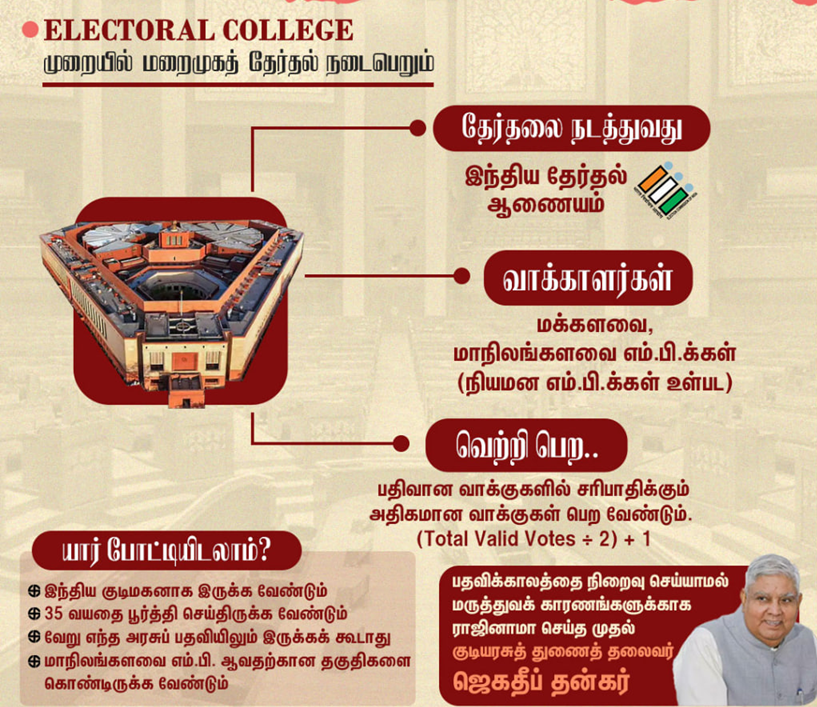PREVIOUS
Vice-President election 2025
July 31 , 2025
12 hrs 0 min
100
0
- Jagdeep Dhankhar resigned from the post on July 21, 2025.
- It created a rare mid-term vacancy in the constitutional position.
- The Election Commission of India has received the gazette notification issued by the Ministry of Home Affairs notifying the resignation.
- The Election Commission of India begins preparations to elect the Vice-President.
- It has appointed the Secretary General of the Rajya Sabha, P.C. Mody, as the Returning Officer.
- The Election Commission of India, under Article 324, is mandated to conduct the election to the office of the Vice-President of India.
- The election to the office of the Vice-President of India is governed by the Presidential and Vice-Presidential Elections Act, 1952.
- And the rules are made thereunder, namely the Presidential and Vice-Presidential Elections Rules, 1974.
- The nomination paper has to be subscribed by at least 20 electors as proposers and at least 20 electors as seconders.
- It has to be presented to the Returning Officer, between 11 a.m. and 3 p.m. on any day appointed for the purpose.
- It is either by the candidate himself or by any of his proposers or seconders.
- The Security Deposit for the election is ₹15,000.
- By convention, the Secretary General, Lok Sabha or the Secretary General, Rajya Sabha is appointed as the Returning Officer, by rotation.
- During the last vice-presidential election in 2022, the Secretary General of the Lok Sabha was appointed as the Returning Officer.
- Two other senior officers of the Lok Sabha/Rajya Sabha Secretariat are appointed as the Assistant Returning Officers.
- The Vice President is elected by the Electoral College.
- It consists of all the members of the Rajya Sabha and Lok Sabha, both elected and nominated.
- They are free to vote as they wish and are not bound by the party whip.
- The Vice-President holds office for five years.
- The VP is also the Rajya Sabha Chairman.
- It is second second-highest constitutional position of the country.
- However, notwithstanding the expiration of his term, he will continue to remain in office until his successor takes charge.
- In the case of death, removal or resignation of the Vice-President, Constitution does not provide any method of succession apart from a fresh election.
- In such an event, the Deputy Chairman can head the Rajya Sabha proceedings.
- Thus, in case of a resignation, the Election Commission has to call for elections immediately, as the position cannot be left vacant.
- As per Article 66 (1) of the Constitution, the election of the Vice-President shall be held “in accordance with the system of proportional representation by means of single transferable vote and the voting at such an election shall be by secret ballot.”
- The election method denotes that every elector has as many preferences as candidates contesting the elections.
- The winning candidate has to secure the required quota of votes to be declared elected.
- It is 50% of the valid votes cast plus 1.
- Unlike the Presidential election, where the value of votes cast by the Members of Parliament and of the various State Legislative Assemblies is different, the value of every vote cast in the Vice-Presidential election has the same value, that is, one.

Leave a Reply
Your Comment is awaiting moderation.


